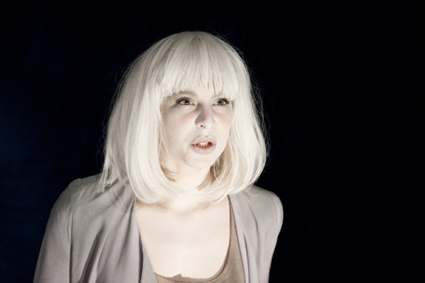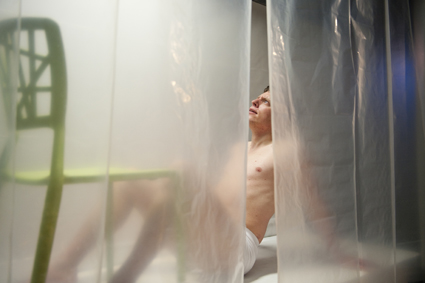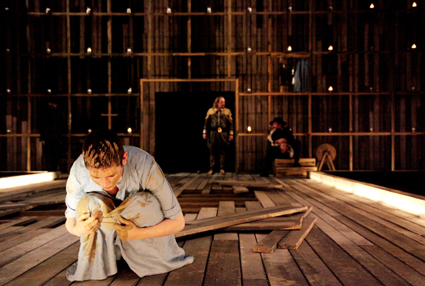just whose theatre?
john bailey: melbourne performance

Cate Wolswinkel, J.A.T.O.
photo Sarah Walker
Cate Wolswinkel, J.A.T.O.
FOR SOME TIME AUSTRALIAN THEATRE HAS BEEN SUBJECT TO A SIMMERING YET PERSISTENT ANXIETY SURROUNDING THE FUTURE OF THE PLAYWRIGHT. THE ARGUMENT HAS BEEN REHASHED AGAIN AND AGAIN—THAT AN EMPHASIS ON COLLABORATIVE DEVISED WORKS, NON-TEXT-BASED PERFORMANCE AND CROSS-DISCIPLINARY HYBRIDITY DEVALUES THE ART AND CRAFT OF GOOD OL’ FASHIONED THEATRE WRITING. BUT FOR A GLISTERING MOMENT IN MELBOURNE RECENTLY, ALL DEBATE SEEMED QUELLED AS A RATHER ASTONISHING NUMBER OF NEW AUSTRALIAN WORKS PREMIERED ACROSS THE CITY. YOU COULD WITNESS A DIFFERENT PRODUCTION BY A LOCAL WRITER EVERY NIGHT OF THE WEEK AND STILL BE LEFT WITH MORE UNSEEN.
mka: for playwrights
One company heralding a writer’s renaissance is MKA, a fledgling enterprise whose emergence was anything but simple. Originally based in a converted warehouse apartment in Richmond, MKA’s inaugural season was delayed after the local council ordered the closure of the venue due to complaints from neighbours. An interim space was quickly found in the CBD where a series of 25 play readings introduced Melburnians to the company’s precis—theatremaking that focuses on the development and presentation of original works that put writing first. A third venue in Prahran was host to MKA’s first season proper, comprising four plays of radically different tone and genre, while no less than the Melbourne Theatre Company has come on board to present another short series of readings produced by the group.
The four productions that made up this primer were of varying success. Nathaniel Moncrieff’s Sleepyhead proved a less-than-stellar opener, in part due to missteps in the writing. Positioning itself as an entry in the Australian Gothic genre, it both gestured towards familiar tropes and well-worn themes while not quite grasping the innate ambivalences which underscore the gothic.
A pair of sisters live in a rural shack with a drunk dad grieving the loss of their mother. His benign admonitions, intended to protect them from the harsh realities of life, force them to seek out other ways of escaping this stifling existence, from fantasy and a patchwork spirituality to a dangerous encounter with a stranger who may or may not be a serial killer. Along the way, the ghost of their mother frequently drops by to ratchet up their sense of guilt a notch, while the recurring disappearance of local girls adds a sinister foreboding to proceedings.
Once these elements are assembled however, it’s not quite clear how they are to interact, or what we can really take from them. The standards of the genre are all there: the imperilled young girl, the monstrous male, the fusing of psychology and environment, the return of the repressed, the descent into hysteria. Yet it’s a passive engagement with these notions that eventually plays out, neither problematising their historical meanings nor tapping into their enduring appeal.
Of a radically different order is MKA’s follow-up, 22 Short Plays, which is so self-mocking as to amount to an ideal snapshot of postmodern theory in theatrical form. Delivering precisely what it promises—22 tiny comic vignettes, often a mere minute or two in length, ‘Plays’ may be a misnomer; there’s little approaching character or plot here. But as scenes that quickly establish a recognisable theatrical mode before immediately dismantling it, the production works. The undergraduate atmosphere doesn’t really detract, indeed seeming entirely appropriate to a production that steadfastly refuses to take anything—least of all itself—with any seriousness. There’s no subtext here, but there’s almost no sur-text either; scenes are over before they have the chance to develop into something that might approach a critical comment on, well, anything. It’s very funny and deliberately pointless.

Matt Young, The Horror Face
photo Sarah Walker
Matt Young, The Horror Face
Somewhere between these two works is The Horror Face, a triptych of shorter works by MKA general manager Glyn Roberts. Though set in a dystopian future of clones and corporate control, the work doesn’t sit comfortably in strict science fiction mode. The scientists and company drones of each scenario are linked by the deadly spirit of a spectral lion; the significance of this is left teasingly open. Another return of the repressed, certainly, but is it the animal nature of the subjugated human or the vanquished spectre of nature itself? The other theme that connects the suite is that of the philosophical poverty of self-help and motivational speaking; again, there’s little direct statement made but plenty upon which to ruminate. The production itself suffered from some awkward staging, directing attention away from the writing’s more contemplative aspects, but it certainly came closer to matching MKA’s stated brief.
If The Horror Face hinted at the company’s promise, the final entry in its first season made good that vow. J.A.T.O. by Croatian writer Vedrana Klepica married marvellous design and strong performances brimming with intriguing possibility. A three-piece band arrive in Zagreb a tangle of mid-tour conflict and disappointment; a pair of half-hearted security guards are given the absurd task of protecting a politician’s decoy; a lonely woman drowning her sorrows searches for a man to fill her evening. Hovering around all of this is an imminent act of terrorism, though its exact nature is never quite certain.
Setting the action in an expansive sandpit makes for some wonderful moments of theatre; in one particularly effective scene a trickle of sand stands in for blood, and the liquidity of the stuff at times suggests that the entire production is occurring on a slowly shifting sea. There’s also the playfulness of sand itself and this is nothing if not a playful work. Politics and poetry weave their way through the writing, but the ever-present artifice of playmaking prevents the potential for polemic or a naïve form of realism. It’s proof that astute writing isn’t incompatible with the form of post-dramatic theatre and is an encouraging cap for MKA’s first official turn.

Yael Stone, A Golem Story, writer Lally Katz
photo Pia Johnson
Yael Stone, A Golem Story, writer Lally Katz
malthouse: a golem story
It would be remiss to discuss theatrical writing in Melbourne of late without mention of Lally Katz’s sterling A Golem Story at Malthouse Theatre. Katz has been one of the leading lights in playwriting for a decade, but Golem is a departure from her usual mode. It’s a work of restraint and austerity, invoking the uncanny rather than the fantastic. Based on the Jewish fable of the Rabbi of Prague, the writer has stayed unexpectedly true to her source.
The legend of the golem is a fascinating contradiction—steeped in history and tradition, it is also a quintessentially modern figure, a powerful repository of contemporary concerns. In the most well known of golem stories, it is a man created from mud by a Jewish mystic in order to defend his people from violent outsiders. As such, the golem has been harnessed by storytellers for different ends, as a symbol of both hope and solidarity in times of duress and, by less sympathetic revisionists as a kind of secret weapon that deserves suspicion. That ambiguous duality is well represented in Katz’ retelling, where the golem’s meaning is never confirmed.
Katz’ script opens with a brilliantly spare piece of scene setting as a young woman confronts a man:
AHAVA. Is this Prague?
RABBI. Yes. It is Prague.
AHAVA. What year is it?
RABBI. It is 1580.
AHAVA. Am I Jewish?
RABBI. Yes.
AHAVA. And you are the Rabbi?
RABBI. Yes.
To me Ahava seems to be Katz herself, setting forth to engage with a Jewish heritage to which she is in some ways still a stranger. But what results, especially under Michael Kantor’s direction, is not a work of meta-theatrical self-reference such as the playwright’s Goodbye Vaudeville, Charlie Mudd or Lally Katz and the Terrible Mysteries of the Volcano. A Golem Story is a solemn exploration of the role of the sacred in the modern world, in which Katz and Kantor attempt not to represent the spiritual experience but to reproduce it as immediate experience. Anna Cordingley’s design is a superbly judged mediation of the earthy and the transcendent; the live songs accomplish something similar, as well as reminding the viewer of the connection between voice and the invisible foundations of life (indeed, the word ‘animate’ is from a Latin root that signifies both ‘soul’ and ‘breath,’ as if the two cannot be divorced).
While Katz’ script is a compelling one on paper, the Malthouse production illustrates that a play’s meaning likewise cannot be shorn from its performance, its breath. The art of playwriting doesn’t truly seem in danger of disappearing any time soon, but it takes a lot more than a playwright to make a piece of theatre that truly lives, however brief its time on earth.
MKA: Sleepyhead, writer Nathaniel Moncrieff, director Yvonne Virsik, set & lighting design David Samuel, May 10-28; 22 Short Plays, writer David Finnigan, director Tobias Manderson-Galvin, May 31-June 18; The Horror Face, writer Glyn Roberts, director Felix Ching Ching Ho, June 23-July 9; J.A.T.O., writer Vedrana Klepica, dramaturg Declan Greene, director Tanya Dickson; MKA Theatre, July 14-30; Malthouse: A Golem Story, writer Lally Katz, director Michael Kantor, performers Nicholas DeRossos, Joshua Gordon, Mark Jones, Michel Laloum, Brian Lipson, Dan Spielman, Greg Stone, Yael Stone set & costumes Anna Cordingley, lighting Paul Jackson, musical direction Mark Jones; CUB Malthouse, Melbourne, June 10-July 2
RealTime issue #104 Aug-Sept 2011 pg. 16






